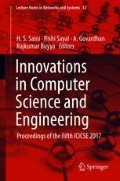Abstract
In today’s era, use of Internet is essential in every aspect of life. It is believed that the students from all discipline as well as computer science background must be susceptible to the internet for effective learning. This paper especially focuses on the student’s usage of the Internet according academic perspective. The objective is to identify most affecting variables which deal with the causes and reasons of possible restriction on usage of the Internet by students. The study has deployed artificial neural network (ANN) model for taking anticipatory measures for predicting use of the Internet. The Levenberg–Marquardt Back Propagation algorithm was used for training with three layers. Optimal artificial neural network model is proposed as a final outcome. Experimentation was carried out in R software.
Access this chapter
Tax calculation will be finalised at checkout
Purchases are for personal use only
References
Chang, F. J., Tsai, W. P., Chen, H. K., Yam, R. S. W., & Herricks, E. E. (2013). A self-organizing radial basis network for estimating riverine fish diversity. Journal of hydrology, 476, 280–289.
Colley, A. (2003). Gender differences in adolescents’ perceptions of the best and worst aspects of computing at school. Computers in Human Behavior, 19(6), 673–682.
Dunham, M. H. (2006). Data mining: Introductory and advanced topics. Pearson Education India.
Frangos, C. C., Frangos, C. C., & Sotiropoulos, I. (2011). Problematic internet use among Greek university students: an ordinal logistic regression with risk factors of negative psychological beliefs, pornographic sites, and online games. Cyberpsychology, Behavior, and Social Networking, 14(1–2), 51–58.
Fijani, E., Nadiri, A. A., Moghaddam, A. A., Tsai, F. T. C., & Dixon, B. (2013). Optimization of DRASTIC method by supervised committee machine artificial intelligence to assess groundwater vulnerability for Maragheh–Bonab plain aquifer, Iran. Journal of hydrology, 503, 89–100.
Joiner, R., Gavin, J., Duffield, J., Brosnan, M., Crook, C., Durndell, A., & Lovatt, P. (2005). Gender, Internet identification, and Internet anxiety: Correlates of Internet use. CyberPsychology & Behavior, 8(4), 371–378.
Maqsood, I., Khan, M. R., Huang, G. H., & Abdalla, R. (2005). Application of soft computing models to hourly weather analysis in southern Saskatchewan, Canada. Engineering Applications of Artificial Intelligence, 18(1), 115–125.
Özcan, N. K., & Buzlu, S. (2007). Internet use and its relation with the psychosocial situation for a sample of university students. CyberPsychology & Behavior, 10(6), 767–772.
Ceyhan, A. A. (2008). Predictors of problematic internet use on Turkish university students. CyberPsychology & Behavior, 11(3), 363–366.
Kisi, O., Tombul, M., & Kermani, M. Z. (2015). Modeling soil temperatures at different depths by using three different neural computing techniques. Theoretical and applied climatology, 121(1–2), 377–387.
Nourani, V., Baghanam, A. H., Adamowski, J., & Gebremichael, M. (2013). Using self-organizing maps and wavelet transforms for space–time pre-processing of satellite precipitation and runoff data in neural network based rainfall–runoff modeling. Journal of hydrology, 476, 228–243.
Author information
Authors and Affiliations
Corresponding author
Editor information
Editors and Affiliations
Rights and permissions
Copyright information
© 2019 Springer Nature Singapore Pte Ltd.
About this paper
Cite this paper
Muley, A.A., Bhalchandra, P.U. (2019). Data Mining of Student’s Internet Utilization Through Artificial Neural Network. In: Saini, H., Sayal, R., Govardhan, A., Buyya, R. (eds) Innovations in Computer Science and Engineering. Lecture Notes in Networks and Systems, vol 32. Springer, Singapore. https://doi.org/10.1007/978-981-10-8201-6_32
Download citation
DOI: https://doi.org/10.1007/978-981-10-8201-6_32
Published:
Publisher Name: Springer, Singapore
Print ISBN: 978-981-10-8200-9
Online ISBN: 978-981-10-8201-6
eBook Packages: EngineeringEngineering (R0)

